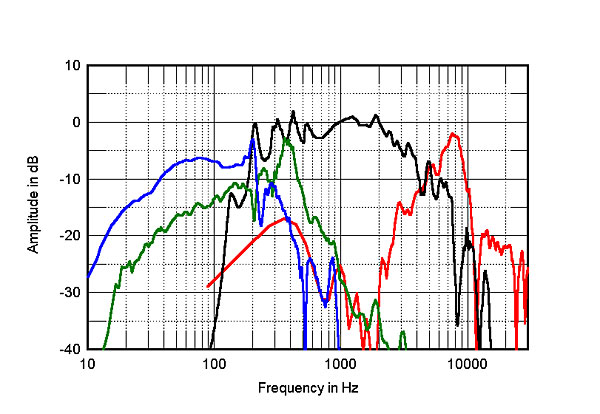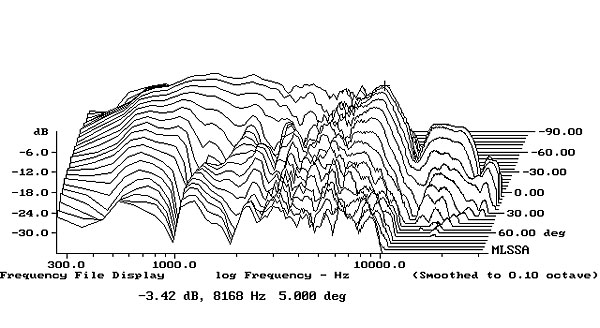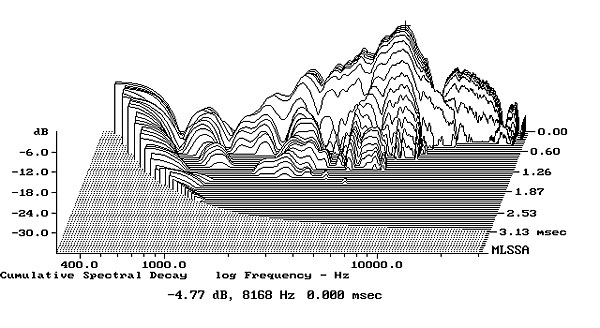| Columns Retired Columns & Blogs |
That frequency response curve is up there in the pantheon with the Dayton Audio B652!
55K per pair vs. 40 dollars per pair.
I wonder how 1,375 pairs of the Daytons would stack up next to the Auditorium 23?

Auditorium 23's floorstanding Hommage Cinema comprises a bass bin with twin powered woofers—a 7" mounted above a 12"—atop which sits an elegant folded horn intended to handle the output of a replica, made in China by Line Magnetic, of Western Electric's classic 555 compression driver, which dates from 1927. Mounted on one side of the bass enclosure is Line Magnetic's replica of Western Electric's 597A compression driver, mounted in a small treble horn. Dating from 1929, the 597A, like the 555, has an aluminum diaphragm and is energized with a field coil.
Art was blown away by what he described as "the speakers' exceptional ease—that too-rare quality in which music is neither shot nor squeezed, toothpaste-like, at the listener, nor left hanging stagnant, half a world away. With record after record, music simply happened; although there's no way to know for sure, I was always left with the sense that the force behind its remaking was on a par with the force behind its making. . . . In the Hommage Cinema, Auditorium 23 has given us what may be the best and easiest opportunity to experience once again a class of loudspeakers that dead engineers forgot to keep making," summed up Mr. D. He concluded that, "As second chances go, it's a hell of a thing."
This was a speaker I needed to hear for myself—and measure—so I packed up my testing impedimenta and hit the road for the 230-mile drive to Artie's lair, in upstate New York.

Measurements
I used DRA Labs' MLSSA system and a calibrated DPA 4006 microphone to measure the Auditorium 23 speaker's frequency response in the farfield, and an Earthworks QTC-40 for the nearfield and in-room responses. I left the woofer-level settings at those chosen by AD for his listening, "6" for the 12" driver and between "4" and "5" for the 7" driver, and the field-coil power supply set to his preferred 6.4V.
My estimate of the Hommage Cinema's B-weighted voltage sensitivity was an extraordinary 102dB(B)/2.83V/m, which is 14dB higher than the average sensitivity of the 750 speakers I have measured since 1989, and almost 20dB higher than the sensitivity of the BBC LS3/5a I always measure at the same time I test a speaker (to ensure that I haven't made an error in setup). If the little British speaker could handle the power, it would need 100W to play at the same level the Hommage Cinema would with 1W. This is heroic engineering! In the 27 years I have been measuring loudspeakers, I have encountered only one that was more sensitive, and it was a musical-instrument speaker: a Fender Bassman 2x15 cabinet.
Not only is the Auditorium 23 sensitive, it is efficient. (The two terms are often confused.) The plot of its impedance magnitude (fig.1, solid trace) suggests that a 15 ohm specification would be appropriate. This means that at 2.83V, the level at which I assess sensitivity, the Hommage Cinema draws 0.53W from the amplifier rather than 1W. With 3.87V, which is equivalent to 1W into 15 ohms, the sensitivity would measure the specified 105dB. The reduction to 10 ohms in the treble in this graph is likely simply due to the tweeter being connected in parallel with the midrange drive-unit rather than with a crossover filter. The impedance trace is typical of a horn speaker, with multiple peaks due to resonances, these most likely due to reflections of the waveform from the edge of the horn mouth back to the throat. The large rise in magnitude in the bass, coupled with the increasingly capacitive phase angle (dotted trace), suggests that the high-pass crossover to the midrange horn comprises a single series capacitor.

Turning to the quasi-anechoic acoustic measurements, fig.2 shows the individual responses of the treble horn (red trace), the midrange horn (black), the upper woofer (green), and the lower woofer (blue). In the case of the three lower-frequency drivers, the farfield response is spliced in the midrange to a nearfield measurement. The midrange output of the horn-loaded midrange unit has small peaks at the frequencies evident in the impedance plot, but the overall trend from 4kHz down to 200Hz, where its output cuts off sharply, is relatively even. It also rolls off above 4kHz, with the small treble horn covering just over an octave above that frequency.

Note that the tweeter actually has some output apparent in the midrange, which I could hear when I listened to this drive-unit on its own. This is why I conjectured earlier that there is no high-pass crossover in the tweeter's feed. At the other end of the audioband, the upper woofer also covers a narrow bandpass, of 300–500Hz, with a shelved-down output below that region. The lower woofer takes over below 300Hz, but there is a narrow peak in its output at 200Hz.
Fig.3 shows how these individual responses sum in the farfield. There is a broad peak in the upper midrange, with the mid-treble shelved down and the response dropping like a stone above 9kHz. The large notch centered on 360Hz is not apparent in the farfield, but resulted from my summing the nearfield outputs of the midrange unit and the woofers. Though three drive-units are connected in phase, the time delay between the output of the horn and that of the woofers (see below) results in destructive interference. The bass is shelved down compared with the midrange, but the lows do offer useful extension to 40Hz or so.

The large-mouthed midrange horn trades increased sensitivity for diminished directivity in its passband, as can be seen in fig.4, although the off-axis output doesn't depart too much from that on-axis, at least until the mid-treble region. This graph shows the off-axis responses on the tweeter side of the speaker to the front; the tweeter offers relatively wide dispersion within its passband, but again, nothing above 9kHz. In the vertical plane (fig.5), the Hommage Cinema maintains its response over a wide (±15°) angle, meaning that listening axis will not be critical. (The center of the midrange horn is 37" from the floor.)


What matters more with a speaker such as this is what happens in-room. The red trace in fig.6 shows the spatially averaged response of the Cinema speakers in AD's listening room. I generated this graph by averaging 20 1/6-octave–smoothed responses taken for each speaker individually in a vertical rectangular grid measuring 36" by 18" and centered on the positions of Art's ears in his listening chair. The blue trace shows the spatially averaged response of the Wilson Duette Series 2 in the same room. (Because of the Wilson's lower sensitivity, its trace has been plotted around 12dB too high, but this makes it easier to compare.)

The Cinema speaker's in-room response is surprisingly even from 200Hz to 2kHz—in fact, more even than the Duette's. As well as being lower in frequency, the primary Allison Effect boundary dip is reduced in amplitude compared with the Wilson, presumably due to the horn speaker's more controlled directivity in the midrange. Art's preferred setting of the woofer levels results in slightly shelved-down lows, without the excitation of the room mode between 60 and 70Hz offered by the Wilson. Above 2kHz, the Wilson has more mid-treble energy, and then a significantly more extended top octave.
AD did write that the Hommage Cinema's treble extension was "noticeably less than one associates with modern loudspeakers, manifesting in lessened air and sparkle with some recordings," though he added that it didn't bother him often. However, I consistently felt in my own listening that even though my hearing cuts off above 15kHz, the lack of top-octave "air" got in the way of the music, especially since the more I listened, the more I was impressed with the dynamic nature of the speaker's midrange. This is something I believe Art refers to when he uses the word touch, and what this magazine's founder, the late J. Gordon Holt, called jump factor.
In the time domain, the Auditorium 23's step response on its midrange axis (fig.7) reveals that the output of the tweeter arrives at the microphone 3 milliseconds before that of the midrange. This is because the midrange compression driver is mounted at the throat of a horn that is 1m long. To obtain a time-coherent output, the tweeter would have to be mounted more than 1' behind the woofer bin, which isn't practical. The tweeter and midrange units are connected in positive polarity. So are the woofers—their step is the lazy rise in output immediately following that of the tweeter in fig.7, and starting to decay just before the midrange step arrives. Again, the midrange output is delayed compared with that of the woofers, which is why I got a cancellation notch at 360Hz when I summed the nearfield outputs of all three drivers (fig.3).

Because the tweeter leads the midrange by so much time, I could plot separate waterfall graphs for them. You can see that the tweeter covers a narrow bandpass centered on 8kHz, but doesn't extend the top octave at all (fig.8). And because its step in fig.7 is so much lower in height than that of the midrange horn, it isn't adding much energy. If—if!—the excellent EnigmAcoustics Sopranino supertweeter were 20dB more sensitive, I remarked to Art when I visited, it would work well with this speaker. But it's not, and the only tweeter I can think of that might match the horn-loaded 555 driver's sensitivity is the horn-loaded Radian compression driver used in Zu Audio's Soul Supreme speaker. The midrange waterfall plot (fig.9) reveals the horn resonances mentioned earlier, but below 2kHz these are relatively mild.


Conclusions
I found Auditorium 23's Hommage Cinema a fascinating loudspeaker to measure. Decades ago, the late Rex Baldock told me that a supersensitive speaker like this could have almost zero nonlinear distortion at normal listening levels, due to the fact that the diaphragm hardly moves. And there was, indeed, something magic about this speaker's midrange. (I remembered that I should have examined distortion only toward the end of my five-hour drive home.) I could live with the Hommage Cinema's low frequencies, even though they're not in the same class as those offered by speakers from Magico, Wilson, or YGA; but, unlike Art, I couldn't live with that lack of top-octave energy.

This is the problem with a horn speaker: To perform at its best, it must be used over a relatively narrow bandpass. This means that a full-range design will need to comprise five separate horn-loaded drivers, which in turn means that the speaker will be large and expensive (footnote 2). But in the Auditorium 23 Hommage Cinema, that superb midrange horn is taken both too low and too high in frequency, and while the designer has solved the problem of matching it with the low-frequency drivers, he hasn't done so at the high end—at least, not to my satisfaction.
But forget what I write—you should give this speaker a listen, just to experience what's possible from a classic compression driver loaded with a horn.—John Atkinson
Footnote 2: See, for example, Magico's Ultimate v.3.

Pretty cool to have your own term created in the English language! Kudos to that... and a great word!
Great review again from Art. I still use my trimmed paint brush stylus cleaner for a quick, gentle, daily cleaning- all the way back from his Listener days. I wonder if he still loathes Lou Reed...
Lastly, the measurements on this speaker are really wild!
One could rub their fingers together for enough power!

Horns get about 9db of mechanical gain, don't they?, the Klipsch I once owned had that type of efficiency. Bose claimed their Top Model had 106db efficiency.
Of course, I wouldn't have expected Old Corner Horn speakers to be of interest to an Audiophile Journal. ( or Bose 901s for that matter ).
A person could have a 2A3 tube for Amplification ( or maybe a First Watt from Pass ) there's something magical about that.
Buuuuuut, the Quad 57s were stunning by comparison ( and still are ).
Anyone can build a Horn, if they want to. All it takes is some Bicycle box cardboard and some Hot Glue. Experimenting with various Drivers from any source is a lovely hobby, even a headphone driver will deliver a listenable result.
Nice work
Tony in Michigan

I had the Advent speakers in the mid-70's, and they got a rave review in Stereophile as phenomenally neutral. So I listened to the Klipschorns in Cleveland one day and I thought they had a similar tonality. Not bad for horns, eh? I think the ultimate audio project would be to construct a physical recording system (no electronics), direct-to-disc from horns or whatever, with the goal to see how much fidelity can be captured without electronics. Cost no object, no limit on the material types or sizes.

I rather like Horns buuuuut they're so darn big. Size is the problem. A tiny box like LS3/5a or ProAc Tablette or Genelec 8020 will match the large horn's functionality, so why bother?
Loudspeakers are for Sharing music, otherwise a person could get by with a pair of Audeze, Focal, Sennheiser or Etymotic personal audio transducers. Wanna Share?, switch to the Loudspeakers.
Now-a-days, I can go for months without turning the loudspeakers on!
Tony in Michigan

I was just in my "retirement" shop using my Li battery powered tools with the "idea" popping in my head. Geez, a person could power a complete home audio system with these darn power tool batteries.
DeWalt have Li batteries that store and make available 9 Amp hours of energy! , I can charge these batteries with one 175 Watt Solar Panel. Viola! The possibility of a Solar Powered music system is here, Today!
Solar Power is where Horn's make sense!
How powerful are these battery systems?, powerful enough for Building Contractors.
Now, can JA please try powering these Horns with one of his personal audio rigs? Maybe the AK 240
Mr. Dudley might be onto sump'n here! ( irony of ironies : Mr.AD starting a Solar movement using Class D amps. )
Tony in Michigan

I cannot understand the sense and the purpose of this report.
The loudspeaker A23 homage Cinema should be a homage to film loudspeaker of the 30s according to his name. The chassis are detailed-exact replikas of ancient WE-originals. Consciously the designer does not go to the frequency ends. This does not interest him at all. Otherwise owners from wideband-loudspeakers could not hear enjoyably music. To expand the frequency-ends of a loudspeaker is nowadays generally no problem. And this works already with cheap chassis. In contrast to those possibilities the chassis of LM are very expensive. This should qualifies the Price of the loudspeaker. To the good end: concerning the bass I have heard on the High End Munich year after year no worse loudspeakers than those of Magico. The listeners often smile after the first tones. Pure compassion because of the bass; BUMBUMBUM :-)))))

Nothing past 9K and these cost 55K. What sounds would we miss if there were no sounds above 9K in the natural world - the one outside Art's listening room. With nothing above 9K what would a symphony in a real world setting sound like? Or even an average recording on any past or modern day format? Absurd viewpoint.

John,
IIRC from some years ago a pricey Raven ribbon tweeter also offered in excess of 100 dB, possibly even that same 105 dB but certainly over 100. I remember hearing it at an event hosted by Morrison, "Blackie" and some wild looking tube gear by Slagle was there. Also kimono-dressed attendants in drag. I vaguely think that Herb Reichert may also have been there, not sure, it was many years ago. A very strange event indeed but I remember those ribbons.

Hi Guys,
I own the A23 Hommage Cinema speaker for three years now and wanted to share my opinion to make a few things and aspects clear.
The review was written by two different persons.
In my opinion one person is a music lover and aesthete and the other a lover of his equipment and data sheets (among other responsibilities).
To benefit from these two perspectives you have to decide what you are focused on while listening to recorded music.
Any passionate music lover must give the Hommage Cinema a try. You will be astonished by it´s beautiful, rich, detailed sound and highly dynamic music reproduction. I assure you that it is deeply impressive.
Like to many other owners of the Hommage Cinema, it may mark the end of a long search for authentic music experience. It may be the path you have been seeking.
On the other hand, if you are the analytical, data driven personality, please also go listen to the Hommage Cinema. Listen to the music and it´s essential qualities. To the delicious high frequency reproduction, not to a tweeter. Go ahead and play your recordings - all of them - and I assure you that you realise it is nearly impossible to get poor sound from the Hommage Cinema.
Yes, they are very efficient. They require only a modest tube amplifier to bring out the finest qualities in your music.
Maybe you will fall in love with your music again. Isn´t that what this is all about?
Yours,
Paul Denton